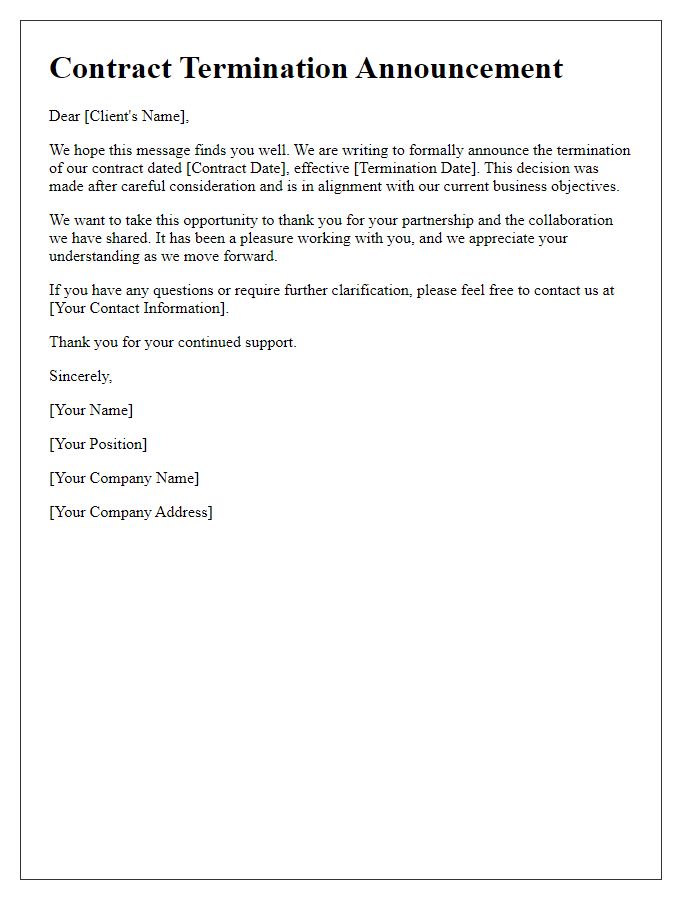Navigating the delicate process of terminating a client relationship can feel daunting, but it's an essential skill in maintaining a healthy business ecosystem. In this article, we'll explore why and how to approach this situation with professionalism and empathy. From recognizing the signs that a partnership may no longer be beneficial to crafting a respectful farewell letter, we've got you covered. So, if you're ready to tackle this challenge with confidence, let's dive into the details!

Clear Statement of Termination
Termination of client relationships can occur for various reasons, including performance issues or changes in business strategy. A clear statement outlining the termination is essential to establish boundaries and expectations. The decision should be communicated formally and professionally. Indicate the effective date of termination and provide a brief rationale, if appropriate. Address any outstanding matters, such as final invoices or pending deliverables, to ensure a smooth transition. Maintaining professionalism through this process can help preserve future business opportunities or referrals. Proper documentation of the termination serves as a record for both parties involved.
Reason for Termination
The decision to terminate a client relationship often stems from a variety of factors. For instance, declining communication patterns may signal a lack of alignment in expectations or objectives. In some cases, persistent non-payment of invoices or financial disagreements may create significant strain on the working relationship, making collaboration difficult. The introduction of conflicting business values or strategic directions can also warrant reconsideration of the partnership. Moreover, consistent project mismanagement or unmet deadlines may lead to frustrations, ultimately resulting in the need to part ways. Each situation is unique, requiring careful assessment and professional handling to ensure a respectful conclusion of the relationship.
Timeline and Key Dates
The termination of client relationships can be a complex process requiring careful planning and documentation. Key dates for this process often begin with the initial notification, which should ideally be delivered 30 days prior to the intended termination date. This notification serves as a formal warning outlining reasons, such as dissatisfaction with service or changing business needs. Follow-up communications occur approximately 15 days later, providing the client with time to address any outstanding issues or concerns. The final meeting should be scheduled one week before termination to discuss remaining obligations, including the final invoice and the return of company property. Additional documentation, like the exit survey, may be distributed post-termination to gather feedback on the client experience. Proper management of these timelines can facilitate a smoother transition for both parties involved.
Account Settlements and Obligations
The termination of client relationships often necessitates thorough account settlements and obligations fulfillment. This process encompasses the reconciliation of outstanding invoices, which may include amounts due for services rendered or products delivered. Organizations must ensure all financial obligations are verified--this includes closing any open accounts and addressing any unresolved disputes. It's crucial to communicate closure effectively, notifying clients about the final account statement and ensuring they obtain necessary documentation for tax records. Furthermore, transferring any remaining assets or data, while adhering to privacy regulations, such as GDPR, is vital during this transition period. Organizations must maintain professionalism to preserve the reputation of business practices post-termination.
Contact Information for Further Communication
Client relationship termination can be a delicate process requiring clear communication. Providing contact information ensures a smooth transition. Include your full name, job title, and company name for professionalism. Specify your direct phone number (such as a local area code) and email address for rapid correspondence. Additionally, provide alternative contacts, such as a colleague's details, to address any urgent matters. A final note acknowledging receipts of communication can enhance closure and encourage future engagement, even if the current relationship concludes. This method maintains professionalism and leaves the door open for potential future collaboration.













Comments